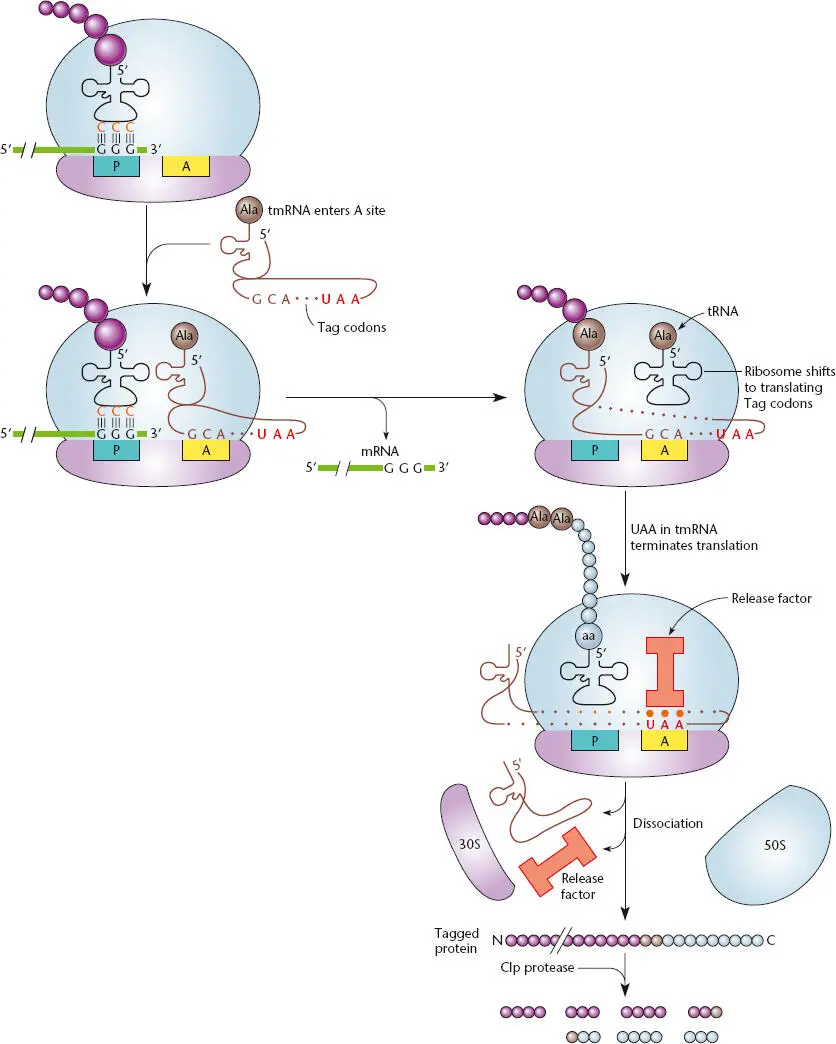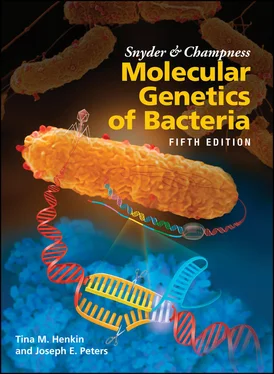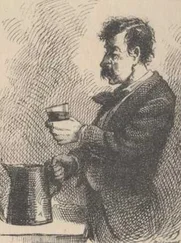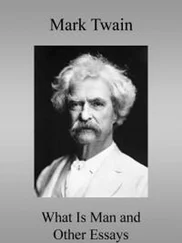BOX 2.4
Mimicry in Translation
The ribosome is a very busy place during translation, with numerous factors and tRNAs cycling quickly through the A and P sites. Different factors have to enter the ribosome for each of the steps and then leave when they have finished their functions. One way the complexity of the system seems to be reduced is by having the various factors and tRNAs mimic each other′s structure, which allows them to bind to the same sites on the ribosome. For example, the translation factor EF-G seems to be roughly the same shape as the translation factor EF-Tu bound to an aa-tRNA. This may allow EF-G to enter the A site, displace the tRNA (now attached to the growing polypeptide), and move it to the P site. Another example is the mimicry between the tRNAs and the release factors. The release factors resemble tRNAs in shape, but they seem to bind to specific terminator codons through interactions between amino acids in the release factors and nucleotide bases in the termination codon, rather than through base pairing between the codon and the anticodon on a tRNA. When the peptidyltransferase attempts to transfer the polypeptide to the release factor in the A site, it sets in motion the string of events that cause translation to be terminated and the polypeptide and mRNA to be released from the ribosome. It is an attractive idea that the release factors replaced what were once terminator tRNAs that responded to these terminator codons. Perhaps, in the earliest forms of life, everything in translation was done by RNA; now, RNA is used to make proteins, and the proteins, being more versatile, play many of the roles previously played by RNA.
Clark BFC, Thirup S, Kjeldgaard M, Nyborg J. 1999. Structural information for explaining the molecular mechanism of protein biosynthesis. FEBS Lett 452:41–46.
Nakamura Y, Ito K.2011. tRNA mimicry in translation termination and beyond. Wiley Interdiscip Rev RNA 2:647–668.
Nyborg J, Nissen P, Kjeldgaard M, Thirup S, Polekhina G, Clark BFC.1996. Structure of the ternary complex of EF-Tu: macromolecular mimicry in translation. Trends Biochem Sci 21:81–82.

Figure 2.30 Termination of translation at a nonsense codon. In the absence of a tRNA with an anticodon capable of pairing with the nonsense codon at the A site, the ribosome stalls, and a specific release factor interacts with the A site, possibly through a specific interaction between amino acids in the release factor and the UAA nonsense codon. Translocation by translation elongation factor G (EF-G) (brown) causes dissociation of the ribosome and release factor from the mRNA, with the assistance of the ribosome release factor.

Figure 2.31 Removal of the N-terminal formyl group by peptide deformylase (A)and of the N-terminal methionine by methionine aminopeptidase (B).
trans -TRANSLATION (tmRNA)
A problem occurs when the ribosome reaches the 3′ end of an mRNA without encountering a termination codon. This might happen fairly often, because mRNA is constantly being cleaved or degraded (often from the 3′ end), and transcription may terminate prematurely, resulting in a truncated mRNA. The release factors can function only at a termination codon, so the ribosome will stall on a truncated mRNA. Not only would this cause a traffic jam and sequester ribosomes in a nonfunctional state, but also the protein that is made will be defective because it is shorter than normal, and accumulation of defective proteins may cause problems for the cell. This is where a small RNA called transfer-messenger RNA (tmRNA)comes to the rescue. As the name implies, tmRNA is both a tRNA and an mRNA, as shown in Figure 2.32. It can be aminoacylated with alanine by alanyl-tRNA synthetase like an alanyl-tRNA, and it also contains a short open reading frame (ORF)that terminates in a termination codon like an mRNA. If the ribosome reaches the end of an mRNA without encountering a termination codon, tm-RNA (together with an accessory protein) enters the A site of the stalled ribosome, and alanine is inserted as the next amino acid of the polypeptide. Then, by a process that is not well understood, the ribosome shifts from translating the ORF on the mRNA to translating the ORF on the tmRNA, where it soon encounters the termination codon at the end of the ORF. The release factors then release the ribosome and the truncated polypeptide, which now contains a short additional “tag” sequence of about 10 amino acids encoded by the tmRNA. The tag sequence that has been attached to the carboxy end of the truncated polypeptide is recognized by the ClpXP protease (see below), which degrades the entire defective polypeptide. In some cases, tmRNA-mediated degradation may play a regulatory role, allowing the targeted degradation of proteins until they are needed (see Keiler and Feaga, Suggested Reading).
As mentioned above, the genetic code determines which amino acid will be inserted into a protein for each 3-nucleotide set, or codon, in the mRNA. More precisely, the genetic code is the assignment of each possible combination of 3 nucleotides to 1 of the 20 amino acids or to serve as a signal to stop translation. The code is universal, with a few minor exceptions ( Box 2.5), meaning that it is the same in all organisms from bacteria to humans. The assignment of each codon to its amino acid appears in Table 2.2.
In the genetic code, more than one codon often encodes the same amino acid. This feature of the code is called redundancy. There are 64 (4 x 4 x 4) possible codons that can be made of 4 different nucleotides taken 3 at a time. Thus, without redundancy, there would be far too many codons for only 20 amino acids. As shown in Table 2.2, some amino acids are encoded by a single codon (e.g., tryptophan), while others use as many as six different codons (e.g., arginine).

Figure 2.32 trans -Translation by transfer-messenger RNA (tmRNA). (A)A ribosome translating an mRNA that lacks a termination codon will stall, because a release factor is unable to bind and release the translation complex. (B)tmRNA, which has features of both a tRNA and an mRNA, enters the A site. (C)The ribosome switches from translation of the mRNA to translation of the coding sequence in the tmRNA, which results in addition of a short polypeptide tag to the carboxy terminus of the nascent polypeptide. (D)The ribosome and mRNA are released, and the tmRNA-encoded tag targets the polypeptide for degradation by the Clp protease system.
BOX 2.5
Exceptions to the Code
One of the greatest scientific discoveries of the 20th century was that of the universal genetic code. Whether human, bacterium, or plant, for the most part, all organisms on Earth use the same three bases in nucleic acids to designate each of the amino acids. However, although the code is almost universal, there are exceptions to this general rule. In some situations, a codon can mean something else. We gave the example of initiation codons that encode different amino acids when internal to a gene than they do at the beginning of a gene, where they invariably encode methionine (see the text). Also, some organelles and primitive microorganisms use different codons for some amino acids. For example, in mammalian mitochrondria, UGA, which is normally a termination codon, instead designates tryptophan. Also, some protozoans use the termination codons UAA and UAG for glutamine. In these organisms, UGA is the only termination codon. Some yeasts of the genus Candida , the causative agent of thrush, ringworm, and vaginal yeast infections, recognize the codon CUG as serine instead of the standard leucine. In bacteria, the only known exceptions to the universal code involve the codon UGA, which encodes the amino acid glutamine in some bacteria of the genus Mycoplasma , which are responsible for some plant and animal diseases.
Читать дальше














